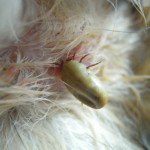
Pet owners in Calgary are finding more and more ticks after their furry companions have been outdoors. When the tick takes a blood meal, they enlarge in size making them more visible. In some cases, the patient arrives at our veterinary clinic to examine a “new mass” that has just appeared, only to find it is a firmly attached, engorged tick. The doctors at Midlake Veterinary Clinic are noticing that many of the pets have not been travelling outside of Calgary, so even local dogs and cats (and therefore people) are at risk.
So far, the most common exposure locales we have noticed at our clinic have been in south Calgary:
- Fish Creek Provincial Park near Sikome Lake in the SE
- Off leash area north of Canyon Meadows Drive at Bow Bottom Trail SE
For travelling dogs, the largest risk appears to be north of Edmonton, plus Saskatchewan and Manitoba.
Since ticks can carry various diseases, monitoring of any ticks found on animals is important for disease surveillance. They can transmit such diseases as Lyme disease, Tularemia, Rocky Mountain Spotted Fever, Ehrlichiosis, Anaplasmosis and Babesiosis.
Any disease that affects both animals AND humans is called a zoonotic disease. Lyme disease, caused by the bacterium Borrelia burgdorferi, is the most commonly known tick borne disease that affects both pets and people. It is carried by the black-legged tick (Ixodes species) in their saliva. Since animals are more prone to getting ticks than humans, animals act as great sentinels of regional Lyme disease activity and the potential for human exposure. Parliamentary Bill C-442 is the National Lyme Disease Strategy Act which addresses the challenges involved with early recognition and treatment of this disease in people. Monitoring exposure in the animal population is key to the success of minimizing the human risk of this disease, not to mention our pet population too. In Calgary, the first step pet owners and their veterinarians can take is identification of the tick species. This would assist health professionals in knowing if Lyme disease could be on the rise in the local community, putting both pets and humans at risk. To date, all ticks submitted by Midlake Veterinary Clinic for analysis have been Dermacentor species ticks, not Ixodes. So fortunately, no Lyme disease cases have been identified at our clinic.
If you find a tick on your pet you can submit the tick for identification at various clinics in Calgary that participate in the Alberta Tick Surveillance Program. Additionally, a dog that has been exposed to a tick can be screened for many of the tick-borne diseases with a simple blood test.
To remove the tick:
- Do not apply anything caustic to the tick such as matches, cigarettes, jellies or other chemicals as this may cause an infected tick to release bacteria into the wound.
- Do not squash the tick making it unable to be identified.
- Using tweezers gently grasp the head as close to the skin as possible and pull slowly with even pressure straight out. Do not twist.
- Place the tick in a clean empty pill bottle or doubled Ziploc bag. No ventilation holes are required.
- Take the tick(s) to a participating clinic, for submission to the Alberta Tick Surveillance Program.
- If in doubt about removing the tick, ask your veterinary team for assistance.
Prevention of tick attachment is best achieved with a veterinary formulated parasiticide. Although there are various products available on the market, only a few of them have proven efficacy and safety studies available to the public. The better products are easy to apply pour-on solutions, not collars, which can be applied monthly as needed.
REMEMBER:
- Some tick products are not broad spectrum and will not prevent attachment of all species of ticks.
- Some products are HIGHLY TOXIC to cats, even those just sharing living space with a treated dog.
- Some products are unsafe in young pups, young kittens and pregnant animals.
So ask your veterinary team which product is right for your family member.





